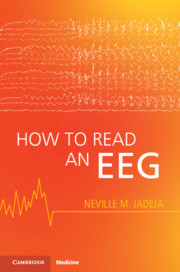
-
Select format
-
- Publisher:
- Cambridge University Press
- Publication date:
- June 2021
- July 2021
- ISBN:
- 9781108918923
- Dimensions:
- Weight & Pages:
- Dimensions:
- Weight & Pages:
You may already have access via personal or institutional login
Book description
The EEG is a simple and widely available neurophysiological test that, if interpreted correctly, can provide valuable insight into the functioning of the brain. However, despite its increasing usage in a range of settings, there is a common misconception that the EEG is inherently difficult to interpret. Compounding the problem is the lack of dedicated training and no standardized approach by encephalographers. This book provides a clear and concise guide to reading and interpreting EEGs in a systematic way. Presented in three sections, the first delivers foundational technical knowledge of how EEGs work, and the second concentrates on a comprehensive, stepwise approach to reading and interpreting an EEG. The third section contains examples of EEGs in common scenarios, such as seizures and post-cardiac arrest, enabling readers to correlate their findings to clinical indications. Heavily illustrated with over 200 example EEGs, this is an essential pocket guide to interpreting these tests.
Reviews
‘How to Read an EEG provides a clear and concise guide to reading and interpreting EEGs in a systematic way … This book is mainly targeted for those looking to learn EEG for the first time and for those wishing to refresh their skills. It contains clear descriptions of typical findings in adults, children, and neurocritical care EEG monitoring.’
Walt R. Banoczi Source: The Neurodiagnostic Journal
‘The book takes a stepwise approach to the interpretation of EEGs. It is particularly effective in highlighting the various EEG patterns readers may come across and the clinical significance of each of these findings. This is something I have not seen systematically addressed in other commonly recommended EEG-reading guides and is a highlight of this book, allowing it to serve as a useful reference.’
Alexander Buslov Source: Doody's Reviews
Contents
Metrics
Altmetric attention score
Full text views
Full text views help Loading metrics...
Loading metrics...
* Views captured on Cambridge Core between #date#. This data will be updated every 24 hours.
Usage data cannot currently be displayed.
Accessibility standard: Unknown
Why this information is here
This section outlines the accessibility features of this content - including support for screen readers, full keyboard navigation and high-contrast display options. This may not be relevant for you.
Accessibility Information
Accessibility compliance for the PDF of this book is currently unknown and may be updated in the future.


